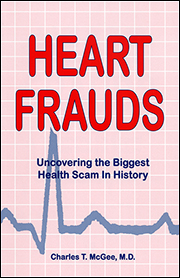E-Mail Edition Volume 13 Number 4
Published Summer, 2016
Published by Piccadilly Books, Ltd., www.piccadillybooks.com.
Bruce Fife, N.D., Publisher, www.coconutresearchcenter.org
If you would like
to subscribe to
the Healthy Ways Newsletter
Contents
-
Unpublished Studies Disproved Saturated Fat – Heart Disease Connection Long Ago
-
A Natural Remedy for Dry Eye, Cataracts, and Other Eye Disorders
-
The Coco Jack
Heart Frauds
by Charles T. McGee
click here to order
Unpublished Studies Disproved Saturated Fat—Heart Disease Connection
Long Ago
An unpublished
study conducted four decades ago, but recently discovered in a dusty
basement, raises new questions about the longstanding dietary advice
regarding saturated fats.
The research,
known as the Minnesota Coronary Experiment, was a major double blind
randomized controlled clinical trial conducted from 1968 to 1973. It
studied the diets of more than 9,400 people at state mental hospitals
and a nursing home. Although the study was conducted over 40 years ago
it was not published until just recently.
This study is
a good example of what happens when the results of an investigation do
not coincide with the prevailing scientific dogma of the time—it doesn't
get published. Numerous studies were conducted from the 1960s through
the 1990s that were designed to demonstrate the dangers of eating
cholesterol and saturated fat, but proved otherwise and consequently
were never published.
In his book,
Heart Frauds, Charles T.
McGee, MD talks about this problem and shares the experience of a
patient of his who participated in a feeding study.1
"John worked in a regional
primate center, one of several research centers funded by the federal
government. One old baboon, named George, was selected to participate in
the study because he had a mean disposition and none of the animal
keepers liked him.
"The staff
dreamed up an experiment in which George was given the opportunity to
give his life for science and not be around to bother them anymore. They
fed the old baboon nothing but hardboiled eggs for one year, then put
him down and performed an autopsy.
"Because of
the propaganda about the cholesterol theory, the staff confidently
expected to find massive obstructions in the old baboon's arteries. They
dreamed of seeing their names in large print on the top of a published
scientific paper supporting the widely accepted and popular cholesterol
theory."
However, "…no
evidence of atherosclerosis was found in George's arteries, no paper was
written. The feeding study demonstrated once again … that studies that
do not support an accepted theory usually don't get published."
Today,
saturated fat is not considered the evil demon it was a few years ago.
The medical community is now acknowledging that saturated fat may not be
so bad after all. Fortunately the data from the Minnesota study has been
found, analyzed, and published.
The Minnesota Coronary Experiment, was paid for by the National Heart, Lung and Blood Institute and led by Dr. Ivan Frantz, Jr. of the University of Minnesota Medical School. Many diet studies have relied on the participants' memory in recalling what they ate over previous days or weeks. Such studies are limited by the accuracy of the subjects' memories, and therefore, are not totally reliable. This study was significant because the researchers were able to tightly regulate the diets of the institutionalized study subjects so
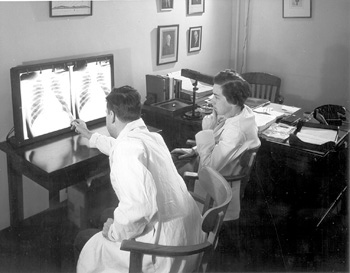
Dr. Harriet L. Hardy First Chair of the Committee on the, Use of Humans as Experimental Subjects, with Dr. Ivan D. Frantz, Jr.
The Minnesota
Coronary Experiment, was paid for by the National Heart, Lung and Blood
Institute and led by Dr. Ivan Frantz, Jr. of the University of Minnesota
Medical School. Many diet studies have relied on the participants'
memory in recalling what they ate over previous days or weeks. Such
studies are limited by the accuracy of the subjects' memories, and
therefore, are not totally reliable. This study was significant because
the researchers were able to tightly regulate the diets of the
institutionalized study subjects so that they knew exactly what the
subjects ate. Half of those subjects were fed meals rich in saturated
fats from milk, cheese, and beef. The remaining group ate a diet in
which much of the saturated fat was removed and replaced with corn oil,
a polyunsaturated fat that is common in many processed foods. The study
also had the benefit of detailed autopsies on 149 patients who had died
during the study. The study was intended to show that removing saturated
fat from people's diets and replacing it with polyunsaturated vegetable
oil would protect them against heart disease and lower their risk of
mortality.
So what was
the result? Despite being one of the largest tightly controlled clinical
dietary trials of its kind ever conducted, the data were never fully
analyzed, and consequently never published. Why put so much effort and
expense into a study and not publish it?
Institutes of Health, learned about the long-overlooked study. Intrigued, he contacted the University of Minnesota in hopes of reviewing the unpublished data. Dr. Ivan Frantz, Jr who died in 2009, had been a prominent scientist at the university, where he studied the link between saturated fat and heart disease. One of his closest colleagues was Ancel Keys, an influential scientist whose flawed research in the

1960s
helped establish the belief that saturated fat was a dietary monster,
prompting the federal government to recommend low-fat diets to the
entire nation.
The younger
Dr. Frantz made three trips to the family home, finally discovering the
dusty box marked "Minnesota Coronary Survey," in his father's basement.
He turned it over to Dr. Ramsden for analysis.
The results
were a surprise. Participants who ate a diet low in saturated fat and
enriched with corn oil reduced their cholesterol by an average of 14
percent. But the low-saturated fat diet did not reduce mortality. In
fact, the study found that the greater the drop in cholesterol, the
higher the risk of death during the trial.
The fact that
blood cholesterol levels decreased when corn oil replaced the saturated
fat was expected, as this had been observed before. What wasn't expected
was the drop in cholesterol was correlated with an increase in the
number of deaths. The findings ran counter to the prevailing belief at
the time that diets low in saturated fat reduces the risk of heart
disease. This study indicated just the opposite.
Preliminary
analysis of the data uncovered the apparent discrepancy with the
prevailing belief at the time. While it is unclear exactly why the
researchers did not complete the analysis and seek publication, but one
possibility is that Dr. Frantz and his colleagues had a hard time
getting it published. If they had sought publication they would have
faced stiff resistance from medical journal editors who might have
refused to publish the study because it questioned a popular and
generally accepted belief that saturated fat promoted heart disease. Any
study that did not support this position was simply out of step with
established scientific belief and considered unreliable, and therefore,
not worthy of publication. Many leading edge studies are not published
simply because they suggest ideas that go contrary to accepted medical
belief.
Another
possibility, and the one that is most likely, is that Dr. Frantz and his
colleagues were so convinced that saturated fat was the problem, that
they couldn't believe their own data and decided not to seek
publication. Maybe they thought the results were just a fluke or perhaps
an undetected error had crept in that influenced the results. This
reason is most likely because Dr. Frantz continued to strongly believe
in the saturated fat heart disease connection even after this study was
completed.
The younger
Dr. Frantz said his father was probably startled by what seemed to be no
benefit in replacing saturated fat with vegetable oil. "When it turned
out that it didn't reduce risk, it was quite puzzling," he said. "And
since it was effective in lowering cholesterol, it was weird."
The new analysis of the Minnesota Coronary data was published, in the April 2016 edition of the British Medical Journal.2 Based on the analysis, the authors concluded that although the replacement of polyunsaturated vegetable oils for saturated fat in the diet can lower blood cholesterol, it does not lower the risk of death from

British Medical Journal

Dr. Daisy Zamora
coronary heart
disease or any other cause. Also, the prejudice against saturated fats
over the years has contributed to the overestimation of the perceived
benefits of replacing saturated fat with vegetable oils rich in omega-6
fatty acids (primarily linoleic acid).
To investigate
whether the new findings were a fluke, Dr. Daisy Zamora, a research
scientist at the University of North Carolina at Chapel Hill and one of
the main authors of the new study, and her colleagues analyzed four
similar, rigorous trials that tested the effects of replacing saturated
fat with vegetable oils rich in linoleic acid. Those, too, failed to
show any reduction in mortality from heart disease.
"One would
expect that the more you lowered cholesterol, the better the outcome,"
Dr. Ramsden said. "But in this case the opposite association was found.
The greater degree of cholesterol-lowering was associated with a higher,
rather than a lower, risk of death." We have been looking at cholesterol
levels the wrong way. Higher cholesterol reduces the risk of death in
comparison to low cholesterol.
One
explanation for the surprise finding may be omega-6 fatty acids, which
are found in high levels in corn, soybean, cottonseed, and sunflower
oils. While cooking with these vegetable oils instead of butter lowers
cholesterol, the high levels of omega-6 can simultaneously promote
inflammation—a major contributing factor to heart disease.
In 2013, Dr.
Ramsden and his colleagues published another controversial paper
involving a large clinical trial that had been carried out in Australia
in the 1960s which also had never been fully analyzed or published.3
Like the Minnesota study, the researchers never had their study
published because the results were not what they had expected. The trial
found that men who replaced saturated fat with omega-6-rich
polyunsaturated fats lowered their cholesterol. But they were also more
likely to die from a heart attack than a control group of men who ate
more saturated fat.
The Australian
study was conducted from 1966 to 1973. One group of men with heart
disease increased omega-6-rich polyunsaturated fat intake to 15 percent
of calories, while reducing saturated fat intake to less than 10
percent. Another group of men with heart disease continued their normal
diets.
The men were
followed for an average of 39 months, and those on the
polyunsaturated-rich diet lowered their cholesterol levels by an average
of 13 percent. But they also were more likely to die, and in particular
to die of a heart attack, than those who stuck with their usual diet,
which consisted of about 15 percent saturated fat.
This study —
the results of which weren't fully analyzed when it was conducted in the
early days of enthusiasm for polyunsaturated oils — adds to a growing
body of data suggesting that consuming polyunsaturated oils, even though
they reliably lower cholesterol, may nevertheless increase the risk of
heart disease.
The science
behind dietary fat may be more complex than nutrition recommendations
suggest. Apparently we can get 15 percent or more of our daily calories
from saturated fat without problem. However, we need to limit our
omega-6 or polyunsaturated fat intake. Our bodies do require omega-6
fatty acids (linoleic acid) in small amounts, about 2 percent of
calories. But emerging research suggests that excess linoleic acid may
play a role in a variety of disorders including liver disease, chronic
pain, diabetes, and heart disease.
A century ago,
it was common for Americans to get about 2 percent of their daily
calories from omega-6 fatty acids by eating whole, natural foods. Today,
Americans on average consume more than triple that amount, much of it
from processed foods like lunch meats, salad dressings, desserts, pizza,
French fries, and packaged snacks like potato chips. Natural sources of
fat such as olive oil, butter, and egg yolks contain omega-6 fatty acids
as well, but in much smaller quantities. Eating whole, unprocessed foods
is the best way to get all the omega-6 fatty acids your body needs,
without getting too much.
1. McGee, CT.
Heart Frauds: Uncovering the
Biggest Health Scam in History. Piccadilly Books, Ltd. 2007.
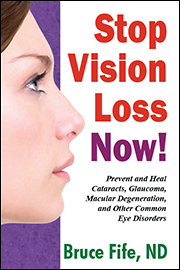
Stop Vision Loss Now!
by Dr. Bruce Fife
Available from Piccadilly Books, Ltd.
click here
A Natural Remedy for Dry Eye, Cataracts, and Other Eye Disorders
A Few Drops
Are All You Need
If you have
used coconut oil on your skin, you know how well it works to sooth and
soften dry skin, fight fungal infections, prevent and ease sunburns, and
speed the healing of minor wounds and insect bites. Coconut oil is not
only great for healing the skin, but is also good for the mucous
membranes. It can be used in the nose, ears, and eyes. Yes, you can
apply coconut oil directly into the eyes. In fact, both coconut oil and
coconut water have pronounced therapeutic effects when applied to the
eyes.
In my book,
Stop Vision Loss Now, I explain how to use coconut oil and
coconut water in the eyes to treat various eye conditions such as dry
eye syndrome, cataracts, and other conditions.
Dry
Eye Syndrome
Do you suffer
from dry eyes? Symptoms include eye irritation, burning, scratchiness,
tearing, stinging, stringy mucus in or around the eyes, and blurred
vision. Most of us experience dry eye on occasion, however, some people
have it nearly constantly. Frequent or chronic dry eye is known as dry
eye syndrome or dry eye disease and can lead to inflammation and
scarring that can seriously affect vision. Dry eye syndrome affects both
young and old, but becomes more prevalent with age. Because of the
increasing prevalence in the general population, dry eye syndrome is now
being viewed as an important public health problem.
Our eyes
constantly produce tears to keep the eyes moist and lubricated. Tears
are made of water, oil, and mucous. Any imbalance to any one of these
three components can lead to dry eye. Dry eye syndrome can be caused by
certain medications, contact lens wear, environmental factors,
dehydration, or deficient diet. Simple treatment consists of
over-the-counter eyedrops (artificial tears). Medicated eyedrops or
surgery may be prescribed in more serious cases.
Lifestyle
plays an important role in the development of this condition. Dry eye
syndrome is far more prevalent among people who sit in front of
computers for six to eight hours a day and others who get very little
exercise. One of the reasons is because when we focus our attention on
display terminals, including laptops, tablets, readers, and Smartphones,
we tend not to blink as often as we should to keep the eyes properly
moist. When we are physically active, our eyes are also more physically
active and we blink more often.
One way to get
immediate relief from dry, irritated eyes is with the use of coconut oil
eyedrops. Melt some coconut oil until liquid and let cool to room
temperature. Use an eye dropper and place 1 to 2 drops of coconut oil in
each eye, close your eyes and move them around to distribute the oil.
Coconut oil will not sting, burn, or hurt the eyes in any way. As the
oil coats the eyeball, your vision will be slightly blurry for a minute
or so. But the oil will lubricate the eyes and make them feel better.
Coconut oil
eye drops are only a temporary fix. If you have chronic dry eye you may
need to make sure you are properly hydrated. Studies indicate that most
adults are mildly dehydrated all the time. Dehydration reduces the
amount of water available to make tears. Coconut water has shown to be
effective in helping to keep the body properly hydrated and thus aid in
easing symptoms of dry eye. Drinking coconut oil once or twice a day is
a good way to help stay hydrated.
Another cause
of dry eye syndrome is eating a low-fat diet. The lack of adequate fat
in the diet reduces the amount of fat produced in tears. Adding a source
of good fat, such as coconut oil, into the diet has proven to be
effective in easing the discomfort of dry eye.
Cataracts
Cataract is
the clouding of the lens of the eye leading to vision loss. Cataract is
the number one cause of blindness worldwide. In developed countries
cataract can be corrected with surgery, however, many people who live in
underdeveloped countries do not have the money or access to the medical
facilities to treat the disease. Ironically, many of those who suffer
from cataracts live in areas of the world that have the perfect solution
to the problem in their own back yards.
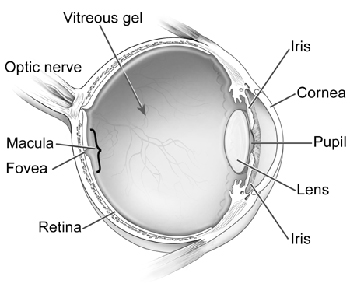
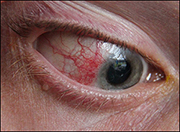
Episcleritis - by Asagan, Wikimedia Commons
In tropical
areas of the world, the solution is growing all around them—the coconut.
Coconut water has proven very effective in treating cataract. Using
eyedrops or an eye cup, the eyes are bathed in fresh coconut water.
Although results vary, many people report dramatic improvement within
just a day.
Diana Little,
MD, was one of those who saw immediate results. "I have practiced
medicine starting with straight allopathic medicine in 1968 and
gradually incorporating complementary and alternative medicine in the
1980s," says Dr. Little. "In spite of various interventions my vision
was steadily worsening. After reading your book
Stop Vision Loss Now. I tried
coconut water for my cataracts.
"On a dark
Michigan evening, I got my coconut opened and followed your protocol.
The next day I went out to walk in partly cloudy conditions. Normally,
my glasses darken so much that with the cataracts I cannot distinguish
patterns on the sidewalk. Amazing! Now I could see—maybe not like when I
was 60 or even 70, but much better. And the other day I saw a returning
brown-headed cowbird on a cloudy Michigan day. No way could I have seen
the shading and color difference of the bird without your ‘cure.' I
shared your cure with the friend I was walking to visit. She tried it
with the same results.
"Thank you for
helping me see the amazing shades of brown in the little sparrows, the
patterns on the sidewalk so I don't trip, and of course, the shadows of
oncoming cars."
Dr. Little was
so impressed with her results that she has now incorporated the
information in my book in her medical practice. "Of course, I make sure
to tell patients and friends they need to do some of the
work—eliminating sugar and processed non-foods and eating healthy fats
like coconut oil and red palm oil."
Episcleritis
Coconut water
eyedrops are not only good for cataracts but for other eye conditions as
well. Episcleritis is an inflammatory disease that affects a part of the
eye called the episclera. The episclera is a thin layer of tissue that
lies between the conjunctiva and the connective tissue layer that forms
the white of the eye (sclera).
Episcleritis is a common condition, and is characterized by the
abrupt onset of inflammation and eye pain, sometimes with the
development of nodules. The cause is unknown and there is no medical
cure for the condition. Treatment focuses on decreasing the pain, which
includes lubricating eyedrops, and with more severe cases topical
corticosteroids or oral anti-inflammatory medications. Often the
condition clears on its own.
"I have had
for well over a year a serious case of episcleritis," says Maria Atwood,
a Certified Natural Health Professional, and a Weston A. Price
Foundation Chapter leader. "I've needed to wear glasses since my very
early childhood, but I've never done anything for my eyes except
obediently get my yearly exam and leave with a stronger prescription
than the one before. That habit abruptly stopped last year when I was
visited with a serious inflammation in my left eye. The sudden redness
and severe pain in my eyeball sent me to a top specialist, and after the
examination he prescribed steroid drops. He also suggested I'd need them
for the rest of my life, as what I had was an incurable disorder—but
since steroids are damaging in the long run [could lead to glaucoma],
I'd need to use them cautiously.
"I used the
steroids, but only until the excruciating pain and redness subsided. Not
only was I baffled as to how this condition originated, but I also grew
fearful of losing my eyesight. To this day I still haven't found the
cause of this eye disorder. To further complicate matters, within two
weeks I felt the severe aching and redness begin in my right eye. Once
again I had to pay a handsome price to visit the specialist and go back
to using the steroids. Talk about depressed and fearful."
Maria was now
suffering from episcleritis in both eyes. She was told she had one of
the more serious cases. Maria described the pain as extreme.
"The pain,
although tolerable after the first two weeks of using the steroids still
left me with extreme eye fatigue, a constant scratchy sense that I had
something in my eyes, and working on the computer became virtually
impossible except for short periods of time."
I gave Maria a
copy of my book Stop Vision Loss
Now and she began reading through it a few pages at a time. She
learned things that she had never seen in any other eye health book. She
saw that some of the foods and supplements I advocate in the book were
absent in her diet and she immediately began to apply some of the
recommendation, including the use of the coconut water eyewash.
"Skeptical that treating my eyes
with the suggestions/recommendations outlined in this book, I
nevertheless began to do them," she says. "I have been virtually stunned
that just after 2 weeks even the residual, although mild pain in both
eyes is completely gone, the scratchy feelings, eye fatigue, and eye
dryness are now much improved. Certainly I am no chemist and cannot
explain this in medical terms. What I can say is that my recovery is
real, and I have been able to return full time to using my computer."
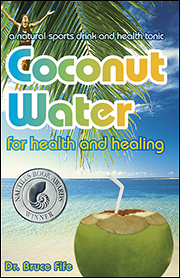
Coconut Water for Health and Healing
by Dr. Bruce Fife
Available from Piccadilly Books, Ltd.
click here
The Coco Jack
One of the
programs I like to watch on TV is the reality series Shark Tank.
Inventors with innovative new products try to convince the
"Sharks"—multi-millionaire business men and women—to invest in their new
businesses.
In 2015 musician turned inventor, David Goodman, demonstrated to the Sharks his new product—the Coco Jack.
The Coco Jack
is a tool to help you open up a young coconut. I was immediately
enthralled. Goodman set the Coco Jack on top of a young coconut and hit
it a few times with a rubber mallet and popped off the top with no
spilling or fuss. It took him all of about 5 seconds to access the water
in the coconut. He then took another tool—a thin bladed scoop—and
scooped out the coconut meat, nearly all of it, in just seconds. I was
amazed. I had to try it myself.
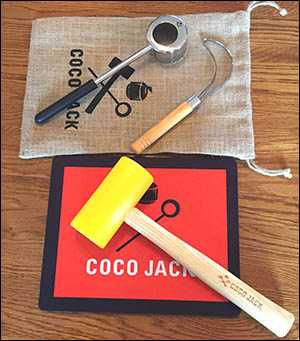
Deluxe Pack comes with Coco Jack tool, rubber mallet, scoop tool, rubber mat, and carrying case.
The shock-absorbing rubber mat was handy, you place the coconut in the center of the mat and hammer away on it without worrying about damaging your countertop. The Coco Jack is placed on the top of a young coconut and hit with the mallet.
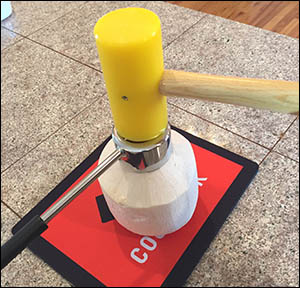
The sharp edges of the Coco Jack are driven into the coconut, making a perfect circular hole. It took me about six or seven good wallops with the rubber mallet to drive the Coco Jack into the top of the coconut.
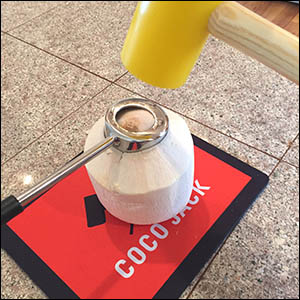
The top popped off fairly easily and violà, . . .
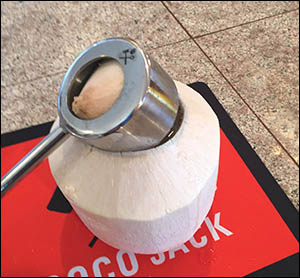
. . . I was ready to enjoy the coconut water.
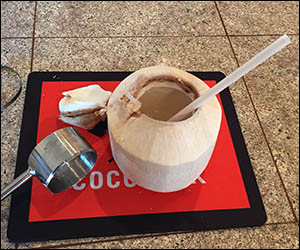
My next task was to extract the coconut meat from the inside of the shell. This is always a chore, so I was curious how well the scoop tool would work. I was really expecting it to take me some time practicing on a few coconuts before I could take the meat out in one piece, as Goodman did on the program.
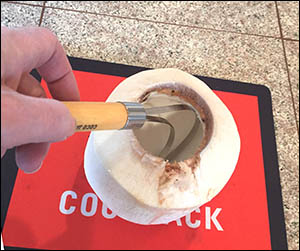
There was a
little bit of a learning curve here, but to my surprise with my first
try I was able to remove nearly all the meat. Now that was impressive.
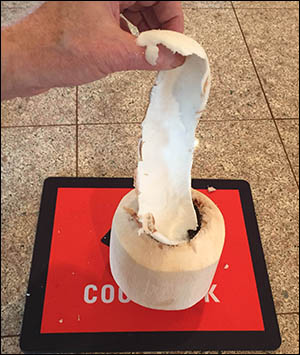
Another tool
that he sells on his website but was not included in my package, was the
coco noodler. When I was in the Philippines a few years back, I was
served an all raw, wheat-free spaghetti dish. It tasted delicious. The
noodles were made from thin strips of very young coconut meat. They
looked and tasted just like pasta noodles. No cooking necessary. The
coco noodler is a tool that you can use to make your own gluten-free
coconut noodles. A great idea!
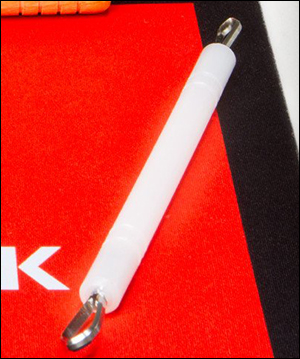
Coco Noodler tool.
Mark Cuban,
Shark Tank investor and owner of the Dallas Mavericks basketball team,
was impressed enough with the Coco Jack to invest in Goodman and his new
business. If you want to learn more about the Coco Jack and its
accessories, go to Goodman's website at
www.coco-jack.com.
Do you have friends who would like this newsletter? If so, please feel free to share this newsletter with them.
If this newsletter was forwarded to you by a friend and you would like to subscribe, click here.
Copyright © 2016, Bruce Fife. All rights reserved.
